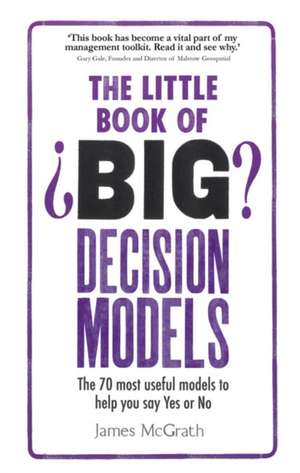The Little Book of Big Decision Models
Autor Jim McGrathen Limba Engleză Paperback – 4 noi 2015
Preț: 70.72 lei
Nou
13.53€ • 14.17$ • 11.20£
Carte disponibilă
Livrare economică 17-31 martie
Livrare express 01-07 martie pentru 23.99 lei
Specificații
ISBN-10: 1292098368
Pagini: 224
Dimensiuni: 137 x 213 x 15 mm
Greutate: 0.34 kg
Editura: Pearson Education
Textul de pe ultima copertă
70 decision-making models to help you make the right choice.
As a busy manager, you need to make daily decisions fast. The Little Book of Big Decision Models gives you access to the very best models that every manager should know and be able to use to make better decisions that get results.
Each model tells you what it is and how to use it so you can instantly put theory into practice and start making great decisions.
The Little Book of Big Decision Models will help make sure you can:
- Discover the most effective decision-making models that the best in the business use to get things done
- Resolve a wide range of practical management problems quickly and effectively by taking decisive action
- Improve your understanding of the environment in which you and your organisation make decisions
- Find out about some of the best - and worst - decisions made in management history
- Be a more effective manager and prepare yourself for promotion
All you need to know and how to apply it - in a nutshell.
Notă biografică
Cuprins
- Chapter 1 - The principles of decision making
- Introduction
- Model 1: Townsend's rules of decision making
- Model 2: The McNamara fallacy - The vital information that decision makers ignore
- Model 3: Using quantitative (hard) and qualitative (soft) data in decision making
- Model 4: Kreiner and Christensen the consequence model
- Model 5: Tenenbaum and Schmid's decision making spectrum
- Model 6: Roger and Blenko's rapid decision making model
- Model 7: Cognitive mapping - understanding how your colleagues think
- Model 8: Tacit knowledge and decision making
- Model 9: The standard decision making model
- Conclusion
- Chapter 2 - Using data in decision making
- Introduction
- Model 10: The Pareto principle and the important vital few
- Model 11: Lewin's force field analysis of the support and opposition to a decision
- Model 12: Scenario analysis and charting possible futures
- Model 13: Delphic forecasting and how to firm up predictions
- Model 14: Johnson, Scholes and Wittingham mapping stakeholder's reactions
- Model 15: Egan's shadow side model - dealing with the politics of decisions
- Model 16: The SCAMPER model and finding creative solutions
- Model 17: De Bono's six thinking hats - generating different perspectives
- Conclusions
- Chapter 3 - Enhancing your decision making skills
- Intrduction
- Model 18: The Eisenhower principle and the delegation of decisions
- Model 19: The feedback and criticism grid
- Model 20: Learning to think outside the box
- Model 21: Goleman: Using emotional intelligence to make better decisions
- Model 22: Sumantra and Bruch reclaiming your job
- Conclusion
- Chapter 4 - Decisions models about you
- Introduction
- Model 23: Christensen's strategy for a happy life
- Model 24: The making - of you model and how your past influences the present
- Model 25: The rubber band model - what holds you back and pulls you forward?
- Model 26: The crossroads model and which road to follow next
- Model 27: The personal performance model and job satisfaction
- Model 28: Csikzenmihalyi's flow model and the joy of working in 'the zone'
- Model 29: Maslow's Pyramids - what you want and what you need
- Model 30: The Euffe Elbaek model - a guide to your personality
- Model 31: Johari windows - a guide to your personality
- Model 32: The personal potential trap and how to avoid becoming a prisoner of other peoples' expectations
- Model 33: Your attitude to risk
- Conclusion
- Chapter 5 - Decision Models about other people
- Introduction
- Model 34: Goffee and Jones - why should anyone be led by you?
- Model 35: Hersey and Blanchard's situational leadership model
- Model 36: Manzoni and Barsoux - how managers set staff up to fail
- Model 37: Denseraeu, Graen and Haga - how managers set staff up to succeed
- Model 38: Herzberg's motivation and hygiene theory - choosing the right carrots
- Model 39: The feedback sandwich - delivering negative feedback
- Model 40: McGregor's features of effective and ineffective teams
- Model 41: The team model - building a well balanced team
- Conclusion
- Cha

